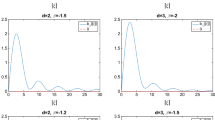Abstract
A smoothed particle hydrodynamics approach is utilized to model a non-Newtonian fluid with a spatially varying viscosity. In the limit of constant viscosity, this approach recovers an earlier model for Newtonian fluids of Español and Revenga (Phys Rev E 67:026705, 2003). Results are compared with numerical solutions of the general Navier–Strokes equation using the “regularized” Bingham model of Papanastasiou (J Rheol 31:385–404, 1987) that has a shear-rate-dependent viscosity. As an application of this model, the effect of having a non-Newtonian fluid matrix, with a shear-rate-dependent viscosity in a moderately dense suspension, is examined. Simulation results are then compared with experiments on mono-size silica spheres in a shear-thinning fluid and for sand in a calcium carbonate paste. Excellent agreement is found between simulation and experiment. These results indicate that measurements of the shear viscosity of simple shear-rate-dependent non-Newtonian fluids may be used in simulation to predict the viscosity of concentrated suspensions having the same matrix fluid.






Similar content being viewed by others
Notes
This earlier paper provides an alternate SPH-based construction of the general Navier–Stokes equations by utilizing the representation of gradients, as found in Eq. 1. As a result, obtaining second order derivatives requires repeated application of Eq. 1. The formulation of the general Navier–Stokes equations in the current paper avoids the direct construction of many of the second-order derivatives through the use of Eq. 9.
Certain commercial equipment, instruments, or materials are identified in this paper in order to specify the experimental procedure adequately. Such identification is not intended to imply recommendation or endorsement by the National Institute of Standards and Technology, nor is it intended to imply that the materials or equipment identified are necessarily the best available for the purpose.
References
Allen MP, Tildesley DJ (1987) Computer simulation of liquids. Claredon, Oxford
Barnes HA (1989) Shear-thickening (“dilatancy”) in suspensions of non-aggregating solid particles dispersed in Newtonian liquids. J Rheol 33(2):329–366
Bender J, Wagner NJ (1996) Reversible shear thickening in monodisperse and bidisperse colloidal dispersions. J Rheol 40(5):899–916
Boek E, Coveney PV, Lekkerkerker HN, van der Schoot P (1997) Simulating the rheology of dense colloidal suspensions using dissipative particle dynamics simulations. Phys Rev E 55:3124–3133
Español P, Revenga M (2003) Smoothed dissipative particle dynamics. Phys Rev E 67:026705
Fielding SM, Olmsted PD (2004) Spatiotemporal oscillations and rheochaos in a simple model of shear banding. Phys Rev Lett 92:084502
Flatt RJ, Martys N, Bergstrom L (2004) The rheology of cementitious materials. MRS Bull 29(5):314–318
Foss DR, Brady JF (2000) Structure, diffusion, and rheology of Brownian suspensions by Stokesian dynamics simulations. J Fluid Mech 407:167–200
Garboczi EJ, Martys NS, Saleh HH, Livingston RH (2001) Acquiring, analyzing, and using complete three dimensional aggregate shape information. In: Aggregates, concretes, bases and fines, ninth annual symposium proceedings (CD-ROM). International center for aggregate research, April 22–25, 2001. Austin Texas, pp 13
Gingold RA, Monaghan JJ (1977) Smoothed particle hydrodynamics: theory and application to non-spherical stars. Mon Not R Astron Soc 181:375–389
Groot RD, Warren PB (1997) Dissipative particle dynamics: bridging the gap between atomistic and mesoscopic simulation. J Chem Phys 107:4423–4435
Hoogerbrugge PJ, Koelman JMVA (1992) Simulating microscopic hydrodynamic phenomena with dissipative particle dynamics. Europhys Lett 19:155:96–160
Israelachvili JN (1992) Intermolecular and surface forces. Academic Press
Kim S, Karrila SJ (1991) Microhydrodynamics. Butterwort–Heinemann
Landau LD, Lifshitz EM (1987) Fluid mechanic. Pergamon, Oxford
Larson RG (1999) The structure and rheology of complex fluids. Oxford University Press, New York
Lootens D, Van Damme H, Hébraud P (2003) Giant stress fluctuations at the jamming transition. Phys Rev Lett 90:178301
Lucy LB (1977) A numerical approach to the testing of the fission hypotheses. Astron J 82:1013–1024
Martys NS (2005) Study of a dissipative particle dynamics based approach for modeling suspensions. J Rheol 49:401–424
Martys NS, Mountain RD (1999) Velocity Verlet algorithm for dissipative-particle-dynamics-based models of suspension. Phys Rev E 59:3733–3736
Moller PCF, Mewis J, Bonn D (2006) Yield Stress and thixotropy: on the difficulty of measuring yield stresses in practice. Soft Matter 2006 2:274–283
Monaghan JJ (2005) Smoothed particle hydrodynamics. Rep Prog Phys 68:1703–1759
Papanastasiou TC (1987) Flows of materials with yield. J Rheol 31:385–404
Zhu H, Martys NS, Ferraris C, DeKee D (2010) A numerical study of the flow of Bingham-like fluids in two-dimensional vane and cylinder rheometers using a smoothed particle hydrodynamics (SPH) based approach. J Non-Newton Fluid Mech 165:362–375
Acknowledgements
We would like to gratefully acknowledge support from the Virtual Cement and Concrete testing Laboratory Consortium (VCCTL). The flow simulations were performed under award SMD-05-A-0129, “Modeling the Rheological Properties of Suspensions: Applications to Cement Based Materials” for NASA’s National Leadership Computing System Initiative on the “Columbia” supercomputer at the NASA Ames Research Center. This research also used resources of the Argonne Leadership Computing Facility at Argonne National Laboratory, which is supported by the Office of Science of the US Department of Energy under contract DE-AC02-06CH11357.
Author information
Authors and Affiliations
Corresponding author
Appendix
Appendix
Proper construction of the weight function W(r) is important for the physically correct transmission of matter or forces between neighboring SPH particles. Here some key properties of W(r) and its derivative are given for convenience. The weight function and alternate formulations are discussed more fully in Español and Revenga (2003), Monaghan (2005).
In this work, the SPH Lucy function is utilized for a weight function.
and
For for the remainder of this paper, we set h = 1. Some of the more important properties of F(r) are given below.
Rights and permissions
About this article
Cite this article
Martys, N.S., George, W.L., Chun, BW. et al. A smoothed particle hydrodynamics-based fluid model with a spatially dependent viscosity: application to flow of a suspension with a non-Newtonian fluid matrix. Rheol Acta 49, 1059–1069 (2010). https://doi.org/10.1007/s00397-010-0480-7
Received:
Revised:
Accepted:
Published:
Issue Date:
DOI: https://doi.org/10.1007/s00397-010-0480-7



